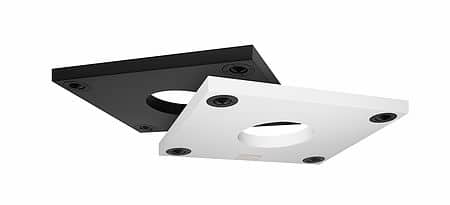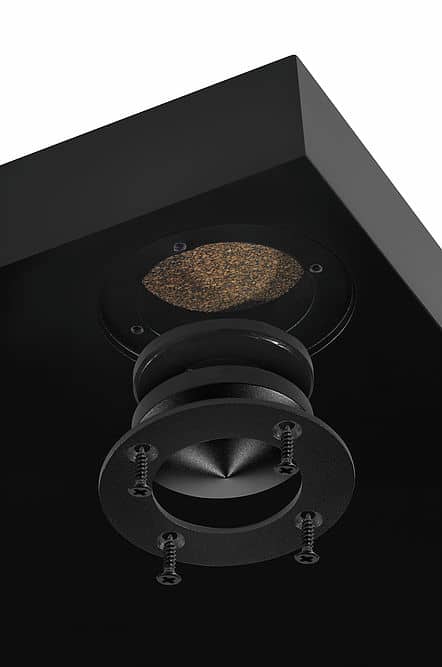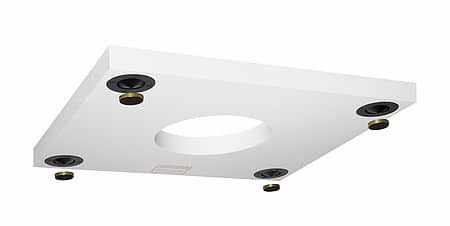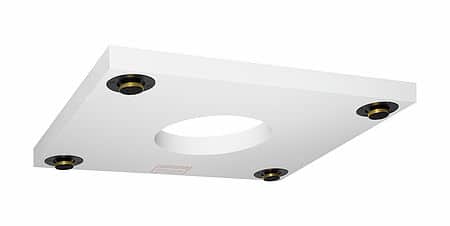The Article
blue horizon’s sanctum provides isolation to your hi-fi
5th July 2016

Looking to rid yourself of destructive noise and or distortive elements from in and around your hi-fi chain? If so, you need to consider isolating your hi-fi components. Paul Rigby looks at one contender, the Blue Horizon Sanctum isolation platform
When you turn on a typical amplifier or CD player or somesuch, if creates noise of varying types. Some of it is drawn from the mains supply, some of it is created by the box itself, from the various components inside and some of it takes the noise from the environment which is them amplified by your components (from the likes of your fridge, your mobile phone, a wooden floor, people moving around, the vibrations from the speakers and a lot more). Wherever it comes from, this horrible stuff is added to the music like a gory recipe from a TV chef, coming out of your speakers and destroying music quality.
Yes, you might get the obvious stuff, the pops, crackles and buzzes but there’s lots of other noise that you don’t really notice until it is gone. Stop believing that ‘noise’ starts and stops with a blaring ambulance sirens, hydraulic drills and Justin Bieber. It’s not. There’s plenty of other types of noise out there that’s far more subtle.
You live in a world of noise but your brain ‘adjusts’ to it to stop you going stark, staring mad. A lot of it is tuned out of your life, in fact. You often don’t even hear it any more. Ever known anyone who lives next to a church with a chiming bell? “Doesn’t that drive you crazy?” you ask. “What? Oh that?” they reply, “Oh we used to hear it when we moved in but we don’t even notice it now.” That sort of thing.
So, a lot of the so-called music that you hear is actually not a true reflection of the music that your hi-fi is actually capable of. It’s music plus noise. Chances are that you are not really hearing your hi-fi in all its glory because noise is surrounding the output signal.
Now, there is a lot – and I mean a lot – of things that you can do to get rid of this noise and you can spend a lot – and I really do mean ‘a lot’ – of money trying to get rid of it (and it’s worth every penny, let me tell you). But if you don’t have multiple thousands to spend on getting rid of noise then you can do the obvious: put your turntable on a simple wall shelf, take the hi-fi components off any big/heavy wooden tables and onto a shelf system of some sort. Even a cheap one is better then nothing. Once there, you can improve things further by isolating each box which gives the noise an easier method of draining itself away to the ground.
This platform is one of those isolating methods. Basically, it’s a ‘shelf’ that you slip under your pre-amp or amp or CD player or whatever. The shelf contains four pointy feet that sit in little brass caps (so the feet don’t scratch your shelf). The shelf itself is made from high density fibreboard (HDF) and is smooth on the top but with a whacking great hole in the middle (to remove ‘standing waves’, apparently). If you flip the board so that you can see underneath it, you will see four recesses, one at each corner. Inside each is an isolation foot made up of three elements: a dense compound of cork, rubber and leather plus a spiked aluminium cone. The Sanctum, available in black or white, measures 450×400×40mm and can support loads of up to 30kg.
So, what effect did it have on my system?
SOUND QUALITY
I began with the Sanctum under my Aesthetic Calypso pre-amp and fired up a slice of Neil Young with Crazy Horse and the LP, Ragged Glory. The differences were immediate and covered just about every aspect of the soundstage and each frequency.
Let’s start with the drums which pounded a resolute beat on this track. Each drum strike sounded freer, as if the drummer was sitting in a larger room, perhaps? Certainly, each time he hit his drum, the resultant sound seemed to continue for a touch longer, the reverb was stretched giving each strike an extra fullness. Onto his cymbals which you can hear as a ‘tinging’ rhythm but there was also a rider cymbal time beat here too. On both, each strike had more realistic ‘ring’.
This tonal realism extended to the guitars which sounded tighter and slightly faster because of it, adding to an overall clarity that made the Neil Young guitar more interesting and exciting to listen to. There was also a rhythm guitar being played on the left channel when Young played his lead on the right. Previously, the left-situated rhythm guitar was rather shy, it seemed to hide in the corner there but now, it seemed more confidant and stronger. I can only associate this result with a lowering of the overall noise floor which may have partially masked some of the information. The new clarity certainly helped this left channel.
As for the vocals? Young sounded, how shall I put this, ‘young’? He had a new found bounce and alertness. Again, this was originally probably down to a slight vocal blurring which was now focused, as you might focus a lens on a camera to sharpen an image. When you have lots of noise over a vocal delivery, it can do horrible things to it and can make anyone sound like Gandalf from Lord of the Rings so toning up the voice by ridding it of unwelcome noise, means that you enhance the articulation. This also assisted the backing harmonies which were fuller and richer in tone.
My pre-amp is a pretty high-end piece of kit (what, 6k? More perhaps?). So what about more ‘real world’ components? Is the platform worth it for a lower cost systems? To find out, I moved to a more budget/mid-range component, Leema’s Elements CD player (£1,375), In order to see if the improvements only affect high-priced kit. I decided to play Bing Crosby’s Bing on Broadway to plug into the great man’s textured vocal delivery plus his small jazz backing group.
You might think that a platform like this wouldn’t change much on a budget piece of kit because, well, only those delicate nuances of the most expensive boxes will register won’t they, eh? Not so, in fact. As the Leema proved, the opposite is true. The lower the cost of each hi-fi component, the more effect this sort of platform has. Why? Because less of the budget to make this CD player was spent on relatively expensive isolation design parts inside the chassis. Hence, the effects, if anything, are magnified.
For example, the Crosby vocal wasn’t only more focussed but the entire soundstage was now 3D-like in structure. Crosby’s voice reached way back into the rear of the soundstage and, for the first time, I noticed the brush strokes from the drummer. Now, of course, he’d been playing this way all along but the effect was never really noticed by me until now which changed the entire nature of song. It was quite startling, actually. Piano too was focused with a new clarity that tightened up each note.
CONCLUSION
Look, if I can find significant improvements from the sound output by putting a single shelf under one component box, what would happened if all of my hi-fi components had Sanctums supporting them? I was impressed at the sonic improvements which were obvious and, especially via the lower costs components, quite startling. Isolation…you need it in your hi-fi life.
BLUE HORIZON SANCTUM ISOLATION PLATFORM
Price: £195
Tel: 0118 981 4238
Website: www.soundfowndations.co.uk
More information from: bluehorizonideas.com
GOOD: reduced noise floor, improved focus and precision, more air and space with midrange
BAD: nothing
RATING: 8

SYSTEM USED
Origin Live Sovereign turntable
Origin Live Enterprise 12” arm
Miyajima Takumi cartridge
Icon Audio PS3 phonostage
Leema Elements CD Player
Aesthetix Calypso pre-amp
Icon Audio MB 845 Mk.II monoblocks
Quad ESL-57 speakers with One Thing mods
Vertex AQ & Atlas cabling





